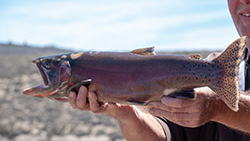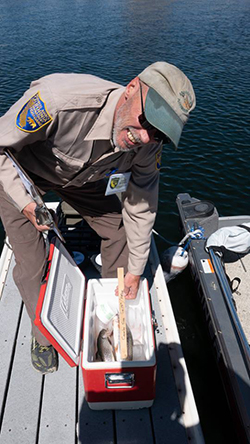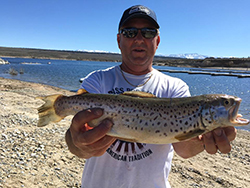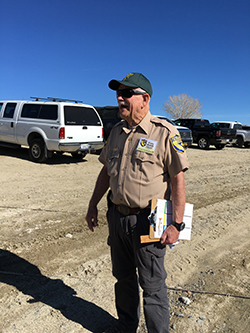 Lahontan cutthroat trout are a Crowley prize. In addition to natural spawning that occurs in the lake, CDFW plants the fish as fingerlings in the fall. By the spring opener, many like this fish are resplendent in their spawning colors.
Lahontan cutthroat trout are a Crowley prize. In addition to natural spawning that occurs in the lake, CDFW plants the fish as fingerlings in the fall. By the spring opener, many like this fish are resplendent in their spawning colors.
 Jim Erdman conducts creel surveys to see how many trout CDFW planted last fall turn up on opening day. Fish 15 inches or longer are determined to be from last fall's stocking when they were planted as fingerlings.
Jim Erdman conducts creel surveys to see how many trout CDFW planted last fall turn up on opening day. Fish 15 inches or longer are determined to be from last fall's stocking when they were planted as fingerlings.
 Mark Risco from Temecula shows off the 20-inch brown trout he caught opening day at Crowley Lake. In addition to natural spawning, CDFW's Hot Creek Hatchery stocks thousands of brown trout each year, which are very popular with Crowley anglers.
Mark Risco from Temecula shows off the 20-inch brown trout he caught opening day at Crowley Lake. In addition to natural spawning, CDFW's Hot Creek Hatchery stocks thousands of brown trout each year, which are very popular with Crowley anglers.
 CDFW volunteer Carl Ronk conducted opening day creel surveys at Crowley Lake along with CDFW Environmental Scientist Jim Erdman.
CDFW volunteer Carl Ronk conducted opening day creel surveys at Crowley Lake along with CDFW Environmental Scientist Jim Erdman.
Mono County’s Crowley Lake is a destination fishery that attracts trout anglers of all kinds – bait fishermen, lure casters, trollers and fly anglers – throughout the state during its open season.
The sprawling lake, situated at 6,700 feet and covering some 5,300 surface acres in the Eastern Sierra, also represents a huge investment for CDFW. The nearby Hot Creek Trout Hatchery raises hundreds of thousands of rainbow, brown and Lahontan cutthroat trout for Crowley each year that provide the backbone of the quality angling experience. Many of the fish are stocked as fingerlings in the late summer or fall and grow rapidly in the invertebrate-rich environment. Some go on to spawn in the lake’s many feeder creeks and supply wild progeny to the population.
All of which helps explain why CDFW Environmental Scientist Jim Erdman has been out conducting creel surveys at Crowley every opening day since joining CDFW in 2005. Based in Bishop, Erdman’s goal is to contact at least 300 anglers and see which hatchery fish are turning up in their catch, in what numbers, in what proportion of species, and in what condition. The report is an annual check to see whether CDFW’s management plan for Crowley remains on point or whether adjustments need to be considered. The opening day creel surveys have been taking place since 1997 when CDFW biologist Curtis Milliron wrote the Crowley Lake Management Plan.
CDFW volunteer Carl Ronk assisted Erdman this past opener April 27. The two split up at times – one checking anglers along the shoreline, the other awaiting returning boats to the Crowley Lake Fish Camp marina, the only formal boat launch at the lake.
Their tools for the day included a clipboard for note-taking and a 15-inch wooden “Crowley Stick” for measuring fish. CDFW biologists have determined that a fingerling trout stocked in the fall should be 15 inches or greater by opening day in the nutrient-rich waters. Erdman typically completes and submits his report by the afternoon of the opener and shares it with anyone interested. Local papers have been known to reprint it in its entirety.
For the 2019 Crowley opener, the creel survey found shoreline angler success was greatly improved from the previous year with an average catch per angler of 3.66 trout compared to last year’s average of just 0.71 trout. Overall, however, catch rates and total catch per angler were lower than 2018. Fish size was also down. Approximately 41.4 percent of the rainbow trout measured were greater than 15 inches, well below the annual average of around 70 percent. The catch rate fell below CDFW’s management goal of one fish per angler for each hour of effort.
A long, cold winter and late ice-out were cited as factors in a slower-than usual Crowley opener and smaller fish with less time to fatten up post ice-out.
“Crowley Lake did not ice-out until April 10, 2019, and this kept fish in deeper water than usual,” Erdman wrote. “No fish were seen in the McGee, Crooked or Whiskey Creek inlets and few to no fish were seen staging for a spawning run. Water temperatures in the inlets remained below 40 degrees.”
Rainbow trout made up the majority of the catch followed by brown trout. Lahontan cutthroats were scarce. CDFW annually stocks 100,000 Lahontan cutthroat fingerlings in the fall. Cutthroats represented just 0.9 percent of the shoreline catch and 1.6 percent of the boating catch compared to 2018 findings of 11.3 percent of the shoreline catch and 2.2 percent of the boating catch.
Opening day on Crowley Lake, with its big crowds and festive atmosphere, has always been about more than bag limits as reflected in Erdman’s creel survey report.
“Returning boat anglers were a bit slower than usual coming in off the lake probably due to the pleasant conditions on the lake. Relaxing in the sun and drifting in the slight breeze. A grand day to be on the water.”
CDFW Photos. Top Photo: CDFW's creel surveys play an important role in evaluating the lake's management and stocking allocations.
###
Media Contact:
Peter Tira, CDFW Communications, (916) 322-8908